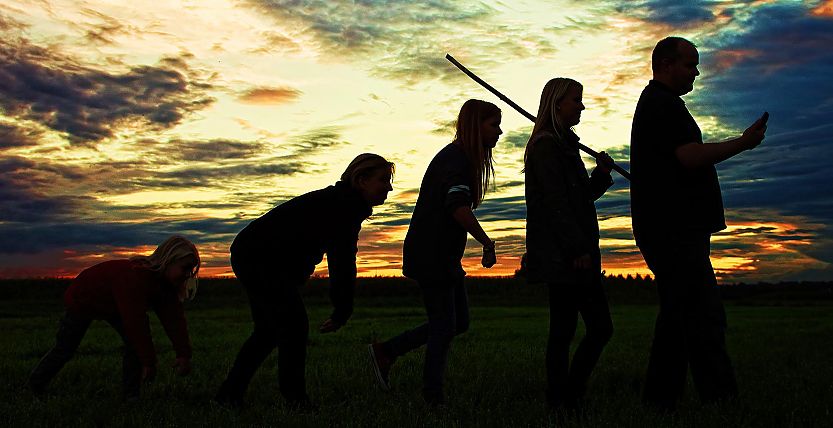
We are living in times of profound and rapid change. From an evolutionary point of view, we humans don’t like this at all: Because a reproduction of yesterday appears to be the safest version of tomorrow.
Digitalization: From overload to sustainable growth
Article
13. Januar 2020 ▪ Reading time: approx. 4:10 min.
The brand is the only business tool that was explicitly created for building trust. It connects the past with the future.
"The only thing that is constant is change" – this quote by the Greek philosopher Heraclitus is 2500 years old. And yet, many people, brands and companies today still act as if the social change we are currently experiencing were an entirely new phenomenon. And like our ancestors, we react instinctively: with insecurity, stunned inaction or flight.
What do employees need to keep them able and willing to act in this fundamentally changing world? To help them cope with the enormous optionality, speed and uncertainty? To allow them to face the digital transformation joyfully and confidently?
Our answer: Employees need understanding and trust. Or rather: Trust through understanding.
Ignorance is the breeding ground of all fear
For companies to master the transition, they need to understand some fundamentals: for one, of course, digitalization itself – but for another, people and their fear of rapid change.
For instance, managers should be aware that ignorance, that is to say not knowing, is the breeding ground of all fear. Sure, we are all ignorant on different aspects of life. You cannot and don't need to know everything. But this is a fact: In today's information age, ignorance is a free decision. To start into the future today, people need something different: they need to open up, need initiative and a will to understand. Companies have to give them that.
The term digitalization is interpreted a lot of different ways. And especially since it has been combined with the buzzword "mindset shift", everyone who talks about it sounds like they know exactly what it is. In our daily work as consultants, however, we notice: It's precisely this multitude of interpretations of the terms that unsettles employees.
The efficiency dogma is unintentionally disrupting our social structures
In centuries past, societies formed with clear hierarchies. As Yuval Noah Harari explains in his book "Homo Deus", the few have always ruled the many. Why? The few had better access to information and stronger networks. During the industrial age, another factor was added: efficiency. The conviction evolved that time is money. A person's significance and relevance are measured by his performance.
In the 60s, the years of the moon landing, a new technology for efficient information exchange was developed: the Arpanet, the predecessor of our internet. Today, it connects people around the world, 24/7, for free. Business and politics are realizing: This is shifting our power structures.
We are living in times of profound and rapid change. From an evolutionary point of view, we humans don't like this at all: Because a reproduction of yesterday appears to be the safest version of tomorrow.
Three success factors for the transformation
The greatest challenge of the digital transformation, then, is not to digitalize analog processes. It is about showing people a new way of thinking and acting. So they can persevere in this new system marked by optionality, speed and uncertainty. In the new system, business owners need
- Decision-making skills
- Momentum
- Trust
It is not easy to embed these three attributes in one's company culture. We are all much too eager to stick to our old routines, because – as we want to believe – it's faster that way and less work.
A brand can offer valuable support during the implementation; it creates a balance in the conflict between consistency and development. It provides security through familiarity and trust.
1. Be sure you have decision-making skills.
The optionality of our time makes lots of people unhappy. It's hard to tell how many options give a sense of freedom – and at what point their abundance overwhelms us. Everything is possible – but is everything reasonable?
Nobody knows the answer, not even the leading minds of business and politics. German Federal President Frank Walter Steinmeier, in his opening speech at the Re:publika 2019, appealed to the public to submit suggestions on how to shape our liberal democracy in this digital world. Steinmeier's appeal shows: What matters is what every individual and the community makes of this epoch.
To make the right decisions, businesses need a common big picture. A moonshot, that is attractive but also credible enables all employees to make the right decisions. When used properly, the moonshot is not just some big crazy goal that could be misused as an ad slogan to attract new customers. It changes the way employees think. They begin to think "from the end": from a point in time when the desired picture will be a reality. The more decisions are made from the viewpoint of this "future present", the faster a business can reach its shared big picture. Simple brand rules embedded in the brand strategy help every individual to handle excessive optionality in their daily operations with confidence and expediency.
2. Take advantage of your momentum.
Momentum is the energy a team or organization develops. Imagine a train: At first it takes an enormous amount of energy to get it rolling. As soon as it is moving, however, hardly anything can stop it. It rolls toward its destination virtually on its own – as long as the tracks, meaning strategy and organizational structure, are set on the right course.
A brand can help with both the initial thrust and the proper course:
- The thrust is symbolic for employee motivation. It is boosted by an attractive vision (moonshot), and by the common "Why" (Why are we doing this)? A brand with a good strategy can answer these questions. It gives employees the chance to identify with the company. Be honest: Does your brand have a goal beyond making money?
- • Now about setting the course: "Habit is the brand's little sister", says BrandTrust founder Klaus-Dieter Koch. In brand management, we often take advantage of the customers' habits for strategic development. This is important – but not enough. Because brands grow from the inside out. That's is why the company culture, this conglomerate of beliefs and habits formed over time, is just as important. The habits have to emerge, the counter-productive ones as well as the productive ones. Find out: Are self-confidence and a willingness to change part of the corporate culture, do employees have a growth mindset?
Every business has to decide which routines are promising and which are not. Hence, an essential part of the brand strategy is the brand core: It describes not only the brand's DNA, but also the success patterns of the past. Top management should pay close attention to this core. It defines credibility limits and gives stability on the road to the shared big picture that holds everything and everybody together.
3. Offer trust and security.
To emerge from this social change with sustainable growth, people, employees need to have trust: in themselves, in their colleagues, their organization. But too many of them are still uncertain. Because of unclear expectations of superiors and constantly changing products, initiatives, strategies and roles that have to be learned. Many eventually give up and refuse to help shape the future.
A well-managed brand can help. A brand emphasizes the fact that one thing remains the same: the big picture, the Why and the How. Its calming power prevents overload and resignation.
The brand is the only business tool that was explicitly created to build trust. It connects the past with the future. It provides orientation, because it defines an attitude and ensures consistent behavior.
So this is what employees need in this new world: a balance of stability and agility. A sturdy framework to support them while they imaginatively shape the future. This is why I am convinced: The brand is the most important tool of the digital world.















